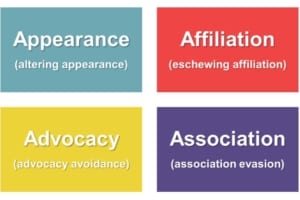June 23, 2021
In Honor of Pride Month—Reflections on Identity Covering
Written by: Jon Hockman, CPF, FASAE
Identity Covering:
Modulating our identities in order to be accepted by the mainstream
Erving Goffman, 20th Century sociologist
Imagine if nearly one out of every two staff at your organization admitted to actively managing or downplaying their differences. The practice, called identity covering, can prevent individuals from showing up in authentic ways and leads to cultures of suppression rather than inclusion. And if you think your organization is an exception to this statistic from Deloitte University’s Leadership Center study, you are mistaken.
Ironically, this blog about identity covering is also a story about my own identity. There are many ways I downplay or cover aspects of my life, but the fact that I’m a gay, married man is one of my most common “coverings.” Is this acceptable or detrimental?
I accept that my role as a facilitator often requires me to focus on clients or the work that needs to be done— after all, there is nothing like an unexpected or out-of-context detail to derail progress. But in this environment of transparency and inclusion, I feel strongly that I need to recognize those times when I cover. Whether I change my behavior is a personal decision and right, but awareness is an important tool for me to be able to show up as my most authentic self.
Let me share an example.
A personal story

In the days before COVID-19, my husband and I often traveled for work. One afternoon, we realized that our return flights would be landing at the same time in the same airport. We decided to meet at the airport food court and head home together. When I saw Kevin, we both smiled and immediately turned to wheel our bags down the walkway. Unlike at home or in another familiar and “safe” environment where we hug or kiss without a second thought, neither one of us made a move.
Kevin and I are an openly gay couple, so why did we avoid a gesture that is second nature in most marriages? This question made me pause. We’ve both experienced uncomfortable — even painful — situations and comments. And at that time in that airport, greeting Kevin with a physical gesture didn’t feel worth the possible risk. Was I covering out of shame? Not at all. I simply wanted to quietly greet my husband and head home together after a few days apart. For me, that was a personal choice and a valid one.
Why do we cover?
At the moment we become aware of behavior that covers our identities, should we change that behavior? For me, the answer is: it’s complicated. In some cases, the answer is yes and in some cases, the answer is no. Identity covering can be a survival mechanism, a coping mechanism, and sometimes it’s the safest and most practical option for me.
For many of us, sharing too much can shut down conversations or momentum because it causes subtle shifts in the behaviors around us. At other times, personal details aren’t germane to the conversation or work that needs to be done. And sometimes we hold back details out of care and concern for others—we don’t need to make our stuff someone else’s stuff. In all of these scenarios, we have the right to be our authentic selves, but we also have the right to privacy.
Implications
Identity covering is subtle and complex. While there is no short answer to whether it’s right or wrong, how can we get better at recognizing it so we’re more self-aware, authentic and impactful as leaders and friends?
The ways we cover
Identity covering isn’t limited to sexual orientation or gender identity. Here are four common ways we mask details of our personal lives.

- Appearance: People may alter their physical appearance, including hair, clothing, etc., to blend in with the mainstream.
- Affiliation: People may change their behavior to avoid being associated with their identity or group and stereotyped by others. For example, someone who prays at certain times during the day may not want to explain that. They still are praying and being true to their beliefs, but not drawing unwanted attention to their practice.
- Advocacy: Individuals may avoid showing public support for their identity or group.
- Association: Individuals may avoid professional or personal contact with people belonging to their identity or group.
The triggers
Recognize what triggers identity covering for you. Reflect without judgment or assumptions by looking objectively at the what and why of your behavior.
Permission
Give yourself permission to decide what your emotional reaction will be to covering. For many, the point of covering is not to deny who you are—it is to manage consequences, protect privacy, or define your own reality.
My takeaway
My takeaway—covering is complicated and a valid response to a complex world. And while there’s no playbook for when it’s right or wrong, it’s always worthy of reflection and change when it’s right for you.
Tag(s):
Governance and Leadership






